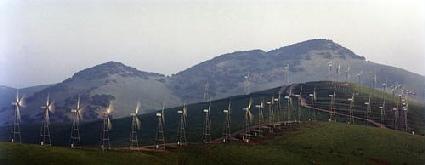|
Five environmental groups in the United States have jointly developed a website that rates the renewable energy options available for consumers. Environmental Defense, the Izaak Walton League of America, the Natural Resources Defense Council, the Northwest Energy Coalition and the Union of Concerned Scientists have launched the Power Scorecard (tm) to provide a tool for rating the environmental impacts of electricity products. Photo shows California's Altamont Pass wind plant produces enough electricity to power the residential sector of a city the size of San Francisco. (Photo by Ed Linton courtesy National Renewable Energy Lab) National surveys show that consumers want to purchase electricity with minimal environmental impacts, but they lack credible information upon which to base their decisions, say the groups. The coalition says renewable energies hold long term promise to protect the environment, improve electric reliability and cushion price spikes. The website rates electricity products in California and Pennsylvania, the two states with the most mature retail electricity markets. Ratings are provided from "excellent" to "unacceptable" based on two criteria: the environmental impact on resources and the amount of energy generated from new wind, solar, geothermal and biomass facilities. "The Power Scorecard makes it easier for Californians to choose cleaner technologies, which have a lower impact on the environment," says Sheryl Carter of Natural Resources Defense Council. "By doing so, consumers send a message to developers and suppliers that there is demand for greener energy. And as the state's electricity portfolio becomes more diverse and clean, we become less vulnerable to fossil fuel spikes and shortages." Electricity generation from different sources will result in vastly different effects on the environment, and environmentalists consider early consumer demand for electricity from new renewable sources to be important because it helps create the financing necessary for the development of even more renewable sources. "Power Scorecard will give citizens the information they need to purchase environmentally friendly electricity," adds Daniel Kirshner of Environmental Defense. "This is a key step towards creating a more sustainable power market in the United States that also allows customers to insulate themselves from the highly volatile fossil fuel based electricity market." "Informed consumer choice has the potential to rapidly advance the introduction of the clean energy technologies that will be needed to meet the environmental challenges of the 21st century," explains Ed Smeloff of Pace. The burning of fossil fuels to produce electricity is the largest source of air pollution in the United States, and emissions from power plants contribute to respiratory illnesses greenhouse gases that are linked with global climate change. Only one percent of California customers have switched electricity suppliers, and the coalition says one reason is the fact that most consumers don't have adequate information to make consistent comparisons. More than 85 percent of customers who have switched have selected a renewable energy product, and officials predict the Power Scorecard will help more consumers make that choice. "Choosing cleaner electricity is an easy, practical solution to help clean up the environment and protect future generations," says Alan Nogee of the Union of Concerned Scientists. "Power Scorecard will help people maximize their positive impact." New Zealand beat the California electricity deregulation in 1996. California and Pennsylvania currently offer the most choices for small customers, and the Power Scorecard evaluations will be expanded to additional states as their electricity markets open up to competition. Pity there is no powerscorecard for New Zealand, the power suppliers here have a reputation which is already subterranean and needs serious competition from solar, wind and water power. $8,000 in solar power equipment will not suffice in New Zealand and yet wind power is needed as a background source for full independence frokm the line companies. Its too much capital cost for most homeowners. .
|

